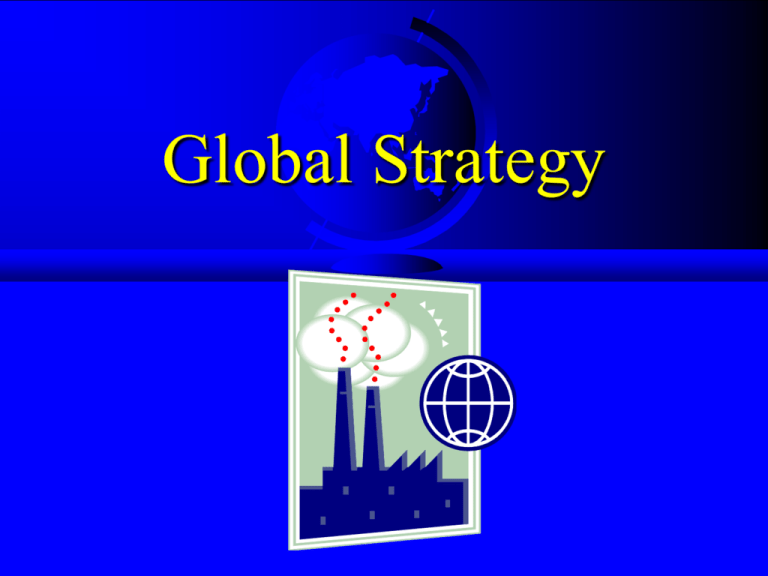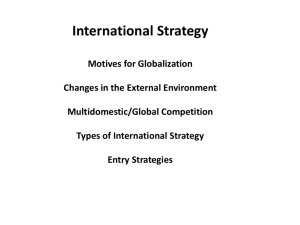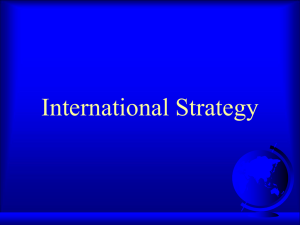International Strategy
advertisement

Global Strategy Procter & Gamble Pan-European Brand Development P&G Multidomestic Strategy UK Neth. France Germany Italy Product Characteristics Map High Washing Temp Enzymatic Stain Removers Fabric Softener Bleach Additives Product Characteristics Map High Washing Temp Excluded countries Fabric Softener Italy Italy Enzymatic Stain Removers Spain Bleach Additives P&G “TransEuro” Strategy UK Neth. France Spain Zone 1 Germany Italy Zone 2 Epilogue VIZIR was precursor to “Liquid Tide” in US – Great irony is: P&G’s struggle to develop “Euro-brand” first found success in another large, integrated market…the U.S. – The VIZIR experience facilitated learning/crossfertilization w/in P&G worldwide – Developed “world-class” technology and product development capabilities worldwide Industry Globalization o o o o o What is a global industry? Why? Which drivers/factors most important? How does a global industry compare with a multidomestic one? How is the extent of globalization “measured”? What are the implications for firms’ international strategies? Globalization Drivers o o o o Market Drivers Cost Drivers Government Drivers Competitive Drivers Low Multi-domestic High Global Definitions Multi-domestic – Many-country view of the international marketplace – Value chain activities are performed in the local country-market and are adapted to local tastes, preferences, needs, etc. Definitions Global – A whole world-level view of the international marketplace, the world is the market – Value chain activities are standardized and are performed in country locations according to efficiency, favorable policies, knowledge, resources, etc. Definitions Transnational – A “glocal” level view of the international marketplace – has some global, some local elements – Some value chain activities are standardized and are performed in country locations others are nationally-adapted and performed in the local market Market Globalization Drivers o o o o Common customer needs Global customers Global market channels Transferable marketing Strength of Market Drivers Aircraft Computers Automobiles Soft Drinks Toothpaste Retail Banking Book Publishing Baked Goods Low Multidomestic High Global Cost Globalization Drivers o o o o o Global scale economies Sourcing efficiencies Factor of production differences High product development costs Rapidly changing technology Strength of Cost Drivers Pharmaceuticals Aircraft Computers Automobiles Toothpaste Retail Banking Baked Goods Soft Drinks Low Multidomestic High Global Government Globalization Drivers o o o Unrestrictive trade and investment policies Compatible technical standards Common marketing regulations Strength of Government Drivers Toothpaste Baked Goods Soft Drinks Computers Automobiles Pharmaceuticals Airlines Retail Banking Restrictive Loose Multidomestic Global Competitive Globalization Drivers o High two-way trade / cross-border FDI o Global competitors o Interdependence among countries o Trade/Investment Policies o Role of WTO, etc. Strength of Competitive Drivers Aircraft Pharmaceuticals Computers Toothpaste Automobiles Soft Drinks Retail Banking Baked Goods Low Multidomestic High Global International Strategy o Globalization drivers – Assess dual pressures: • Global efficiency - standardization • National/local responsiveness - adaptation o Location/configuration of value-creating activities o Integration/coordination of value-creating activities Effective Standardization Coca-Cola’s “transnational polar bears” McDonald’s “Big Mac” Effective Adaptation o o o o McMutton Pie in Australia Wendy’s shrimp sandwich in Japan Campbell’s non-condensed soups in the UK Coca-Cola’s 175 ml containers in Japan Barbie o Barbie is 51 years old o Sold in 130 countries o National adaptations: • Physical features • Costumes • Activity sets o Standardized physique: • Scaled to 6’2”, 110 lbs. Globalization Drivers o o o o Market Drivers Cost Drivers Government Drivers Competitive Drivers Low High Multidomestic Global Pressures for Global Efficiency International Strategy: Managing Dual Pressures High Low Low High Pressures for Local Responsiveness Value Chain Location and standardization/adaptation Infrastructure Technology Development Procurement Human Resource Management Inbound Outbound Operations Logistics Logistics Marketing Profit Margin Service Value Chain Headquarters Infrastructure Technology Development Procurement Human Resource Management Inbound Logistics Operations Outbound Logistics Marketing Profit Margin Service Value Chain Headquarters Infrastructure Technology Development Procurement Human Resource Management Inbound Outbound Operations Logistics Logistics Upstream Marketing Profit Margin Service Value Chain Headquarters Infrastructure Technology Development Procurement Human Resource Management Inbound Outbound Operations Logistics Logistics Upstream Profit Margin Marketing Service Downstream Value Chain Sub-functions (Marketing) Infrastructure Technology Development Procurement Human Resource Management Inbound Outbound Operations Logistics Logistics Advert. Pricing Marketing Distrib. Profit Margin Service Packaging Value Chain Configuration o Geographic location of value chain activities – Concentrated/centralized vs. dispersed/decentralized Value Chain Coordination o o Cross-border linkages between dispersed valuecreating units Coordination = Flows of: – – – – – o $ Product (finished and intermediate) Technology People Information (market data, strategic direction, etc.) Highly coordinated vs. only money flows Pressures for Global Efficiency International Strategy: Managing Dual Pressures High Low Export Strategy Low High Pressures for Local Responsiveness Export Strategy (same as Export entry mode) Germany U.S. Mexico Malaysia International Strategy: Pressures for Global Efficiency Managing Dual Pressures High Low Export Strategy ?? Low Multidomestic Strategy High Pressures for Local Responsiveness Multidomestic Strategy Germany U.S. Mexico Malaysia International Strategy: Pressures for Global Efficiency Managing Dual Pressures High Low Global Strategy Export Strategy ?? Low Multidomestic Strategy High Pressures for Local Responsiveness Global Strategy (Textbook Variety) Germany U.S. Mexico Malaysia International Strategy: Pressures for Global Efficiency Managing Dual Pressures High Low Global Strategy Export Strategy ?? Low Transnational Strategy Multidomestic Strategy High Pressures for Local Responsiveness Transnational Strategy (v.1) Germany U.S. Mexico Malaysia Transnational Strategy (v.2) Germany U.S. Mexico Malaysia Transnational Strategy (v.3) Germany U.S. Engines Steel Mexico Final Assembly Malaysia Trim, seats, glass VW International Strategy - Jetta U.S. Japan Marketing Transmission Mexico Germany Final Assembly Misc. Poland Engine Entry Mode Framework Mindset Country-market opportunity/cost analysis Stand-alone Attractiveness Strategic Importance Resources-Control-Risk tradeoff Mindset and International Activity International Overseas activities support / subordinate to domestic activities Multinational Flexibly adapting value-creating activities on country-by-country basis; nationally-responsive Global The world is the market; standardization Transnational “Glocalization” – Some value-creating activities standardized/globalized, others localized Strategic Importance of Country Entry Mode Decision Matrix Hi Lo Lo Hi Stand-alone Attractiveness of Country Country-Market Analysis Stand-alone attractiveness: – Size – Growth – Product acceptance / segmentation – Cultural similarity – Risk – Policy incentives – Other factors? ….MNC “power”? Country-Market Analysis Strategic importance: – Home market of global customer – Home market of global rivals – Significant market of global rivals – Major source of innovation – Demanding/sophisticated customers – Factor-cost advantages Resources-Control-Risks Resources $$, time, technology, machinery, people, organizational, strategy Control Operational and strategic discretion over value-creating activities Risks Political, F/X, economic, cultural, dissemination Control Extent of involvement: Ship Product Distribution After-sales Support Marketing Channel control / ownership: Export Agent Mfg. Import Agent Regional Whsle. Local Whsle. Retail Entry Mode Decision Framework Control Resources Risk Dissem. Low Low Low High High High High Low Licensing Exporting Intermediaries Direct Joint Venture Wholly-owned Subsidiary Strategic Importance of Country Entry Mode Decision Matrix Hi Lo Lo Hi Stand-alone Attractiveness of Country General Electric and International Involvement GE Product Divisions: Light bulbs Aircraft engines Appliances Power-generation GE Market Opportunity: North America Europe Pacific rim / Asia Emerging markets Product Lines GE’s Markets, Entry and Strategy Choices 4 3 2 1 A B C D Country-Markets Strategic Importance of Country Entry Mode Decision Matrix Hi Lo Lo Hi Stand-alone Attractiveness of Country McDonald’s Identity McDonald’s Site Selection and Stores US -- Colorado McDonald’s Site Selection and Stores Bangkok, Thailand McDonald’s Site Selection and Stores Moscow, Russia McDonald’s Transnational Menu US Brazil Canada Big Mac French Fries Coca-Cola McNuggets McBier PitaMac McFarmer McLobster McCalebresa Germany McAloo Tikki McRib India Hamburger University Illinois, USA Hamburger University Curriculum o 80 classroom hours o Topics – Fast food “the McDonald’s way” • • • • • • Restaurant operations, food preparation Crew selection, training and team building Marketing and promotion Asset management Corporate citizenship and ethics Leadership, effective supervisory skills Hamburger University HongKong London Illinois Sydney Munich McDonald’s Transnational Strategy Singapore U.S. Greece Brazil



